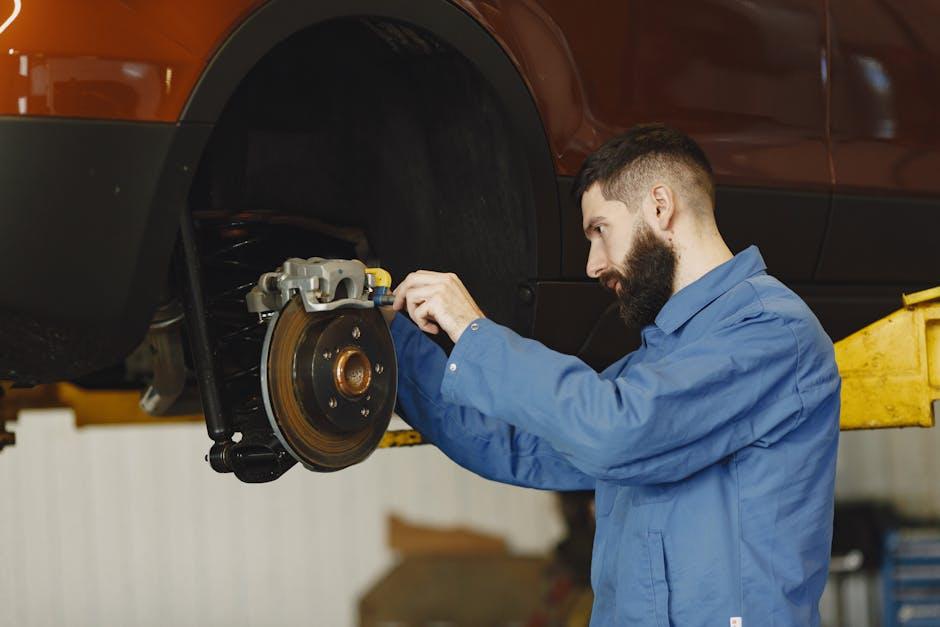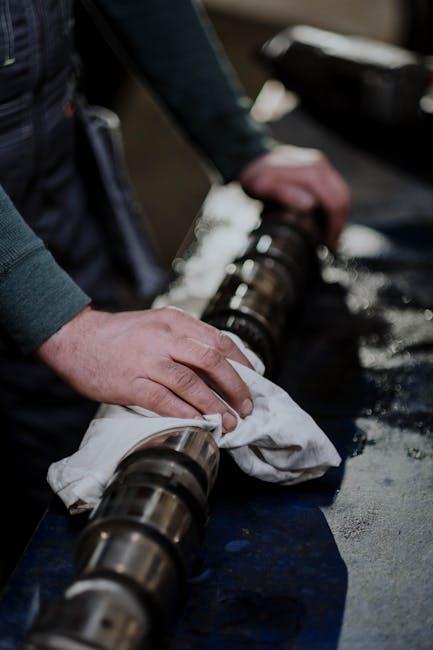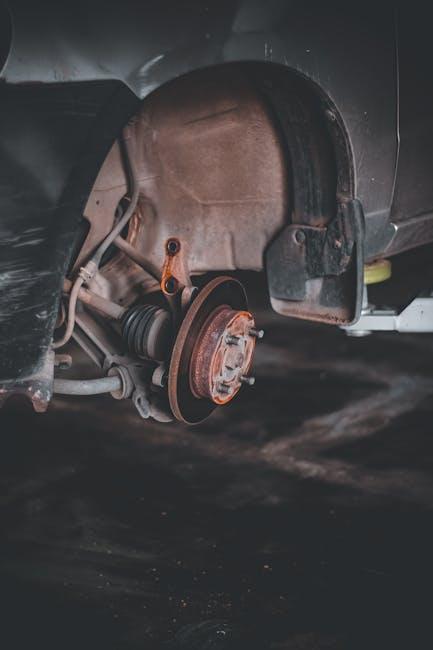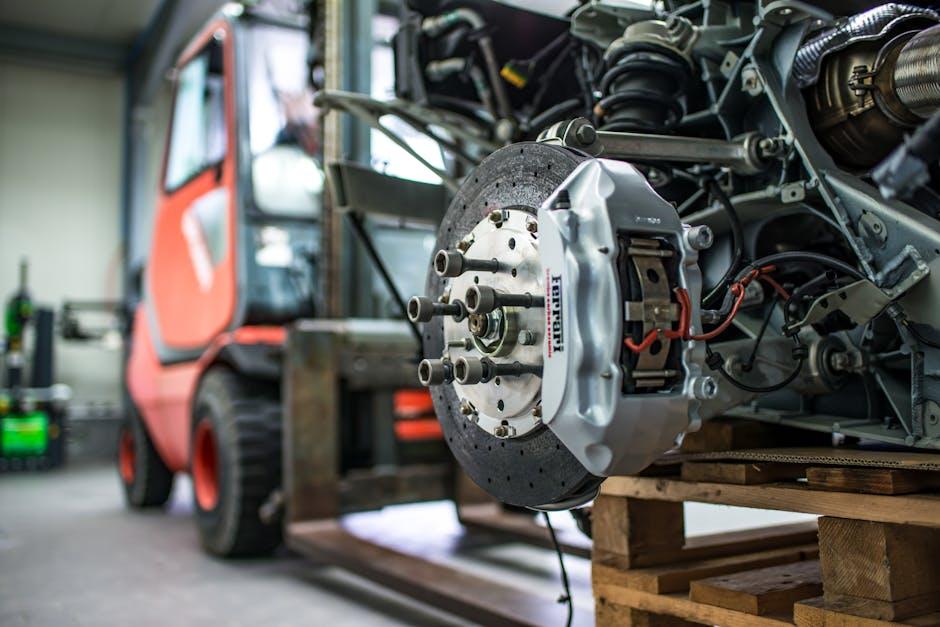Brakes are the unsung heroes of every journey, quietly ensuring our safety mile after mile. Often overlooked until they squeak or falter, maintaining your vehicle’s braking system is crucial for reliable stopping power when it matters most. In this article, we explore essential brake maintenance tips designed to keep your ride smooth, responsive, and—above all—safe. Whether you’re a seasoned driver or a new car owner, understanding how to care for your brakes can make all the difference between confident control and unexpected danger on the road.
Table of Contents
- Understanding the Importance of Regular Brake Inspections
- Recognizing Common Signs of Brake Wear and Tear
- Choosing the Right Brake Pads for Your Vehicle
- Effective Techniques for Cleaning Brake Components
- When to Replace Brake Fluids for Optimal Performance
- Safety Precautions During Brake Maintenance Tasks
- Q&A
- Closing Remarks

Understanding the Importance of Regular Brake Inspections
Ensuring your vehicle’s braking system is in optimal condition is not just a matter of routine maintenance—it’s a critical factor in keeping you and others safe on the road. Over time, brake components such as pads, rotors, and fluid can wear down or degrade, impairing their ability to perform effectively. Regular inspections allow for early detection of wear and tear, preventing costly repairs and unexpected failures. By prioritizing these check-ups, you guarantee that your brakes respond promptly and steadily when you need them most, especially in emergency situations or adverse weather conditions.
During a professional brake inspection, technicians typically look for several key indicators of system health:
- Pad thickness: Thin pads can lead to metal-on-metal contact causing damage.
- Rotor condition: Look for warping, deep grooves, or uneven wear.
- Brake fluid levels and quality: Contaminated or low fluid reduces braking efficiency.
- Brake lines and hoses: Check for leaks, cracks, or corrosion.
| Component | Signs of Wear | Recommended Action |
|---|---|---|
| Brake Pads | Less than 3mm thickness, squealing | Replace immediately |
| Rotors | Warping, grooves, vibration | Resurface or replace |
| Brake Fluid | Cloudy or low levels | Flush and replace fluid |

Recognizing Common Signs of Brake Wear and Tear
Effective brake maintenance starts with understanding the subtle cues your vehicle gives you. Pay close attention to unusual sounds such as squealing, grinding, or clicking when you apply the brakes—these noises often indicate worn brake pads or damaged rotors. Additionally, if you notice a vibration or pulsation through the steering wheel or brake pedal, this could signal uneven wear or warped discs, which require immediate inspection. Another sign is a longer stopping distance—if your brakes don’t respond as quickly or your car seems to slide before coming to a full stop, it’s time to inspect the system.
Visual inspections can be just as revealing. Look for thinning brake pads through the wheel spokes or behind the rims; a pad thickness less than 3mm is a clear warning to replace them. Leaks or dark stains near the wheel wells could suggest brake fluid issues that compromise braking power. To help you keep track of these signs, here’s a quick reference table for brake wear indicators:
| Symptom | Potential Cause | Action Required |
|---|---|---|
| Squealing Noise | Worn Brake Pads | Replace Pads |
| Vibration During Braking | Warped Rotors | Resurface or Replace Rotors |
| Spongy Brake Pedal | Air in Brake Lines | Bleed Brakes |
| Brake Fluid Leak | Damaged Seals or Lines | Repair Leak Immediately |

Choosing the Right Brake Pads for Your Vehicle
When it comes to selecting the perfect brake pads, understanding your vehicle’s driving conditions and manufacturer recommendations is crucial. Different materials such as ceramic, semi-metallic, and organic pads each offer unique benefits, from durability and heat dissipation to noise reduction and smooth stopping power. For city driving with frequent stops, ceramic pads provide quieter operation and less dust, while semi-metallic pads excel in performance and heat resistance during aggressive or mountainous driving. Always consider factors like brake dust levels, lifespan, and price to find the best fit for your daily needs.
Choosing brake pads also involves evaluating your vehicle’s specific requirements. Here’s a quick comparison to simplify your decision:
| Pad Type | Best For | Pros | Cons |
|---|---|---|---|
| Ceramic | Everyday driving | Quiet, low dust, long-lasting | Usually pricier |
| Semi-Metallic | Performance and towing | Excellent stopping power, durable | Noisy, more dust |
| Organic | Soft braking, classic cars | Affordable, gentle on rotors | Wear out faster, less heat resistant |
Ultimately, your choice should balance safety, budget, and driving style to maintain optimum brake performance and peace of mind on the road.

Effective Techniques for Cleaning Brake Components
Maintaining brake components in top condition demands precision and care. Start by carefully disassembling the brake parts and use a dedicated brake cleaner spray to dissolve grease, brake dust, and debris without leaving residue. Avoid lubricants on the friction surfaces like pads and rotors. Instead, apply a high-temperature brake lubricant only to the caliper pins and contact points to ensure smooth movement without contaminating the braking surfaces. Using a soft wire brush or a lint-free cloth helps remove stubborn grime without damaging the delicate metal surfaces.
To prevent corrosion and improve longevity, periodically inspect components such as rotors, pads, and caliper assemblies for wear and rust buildup. Below is a quick reference table for common brake cleaning agents and their recommended uses:
| Cleaning Agent | Best For | Usage Tip |
|---|---|---|
| Brake Cleaner Spray | Grease and Dust Removal | Apply liberally and allow to evaporate |
| Isopropyl Alcohol | Surface Degreasing | Use for wiping down rotors after cleaning |
| High-Temperature Brake Grease | Caliper Pins and Back of Pads | Use sparingly to avoid contamination |

When to Replace Brake Fluids for Optimal Performance
Brake fluid plays a crucial role in the hydraulic system of your vehicle, ensuring smooth and responsive braking. Over time, brake fluid can absorb moisture from the air, which significantly reduces its boiling point and leads to decreased efficiency or even brake failure. As a rule of thumb, it’s recommended to change your brake fluid every 2 years or 24,000 miles, whichever comes first. However, if you notice signs such as a spongy brake pedal, longer stopping distances, or discolored fluid, it’s wise to schedule a fluid replacement promptly. Regular inspections during routine maintenance can help catch these issues early and maintain your vehicle’s optimal braking performance.
Different types of brake fluids require specific replacement intervals to ensure maximum effectiveness. Below is a quick reference table to help you identify when you should consider changing your brake fluid depending on the type used in your vehicle:
| Brake Fluid Type | Recommended Replacement Interval |
|---|---|
| DOT 3 | Every 2 years |
| DOT 4 | Every 1-2 years |
| DOT 5 (Silicone-based) | Every 3-5 years |
| DOT 5.1 | Every 2 years |
Maintaining proper brake fluid quality ensures your braking system responds effectively under all driving conditions, especially in emergency situations. Be proactive about your brake fluid to safeguard your safety and that of others on the road.

Safety Precautions During Brake Maintenance Tasks
Before diving into any brake maintenance task, it’s crucial to prepare your workspace and gear properly. Always ensure the vehicle is securely elevated using reliable jack stands, never just a jack alone. Wearing protective gloves and safety goggles safeguards against harmful dust particles and sharp components. It’s also advisable to work in a well-ventilated area to avoid inhaling brake dust, which can be hazardous over time. Remember to disconnect the battery if working on advanced electronic braking systems to prevent accidental activation.
When handling brake components, pay close attention to the tools and procedures you use. Using the right torque settings is essential to avoid over-tightening or under-tightening bolts, which could lead to brake failure. Here’s a quick reference chart for common brake bolt torque specifications to keep handy during your maintenance:
| Component | Torque (Nm) |
|---|---|
| Caliper bolts | 25 – 35 |
| Rotor screws | 10 – 15 |
| Wheel lug nuts | 90 – 120 |
Finally, avoid rushing any step. Thoroughly inspect all parts for wear or damage before reassembly, and clean surfaces and components to prevent contamination. These simple yet vital precautions contribute significantly to a successful and safe brake maintenance job.
Q&A
Q: Why is regular brake maintenance important for safety?
A: Your brakes are your car’s most crucial safety feature. Regular maintenance ensures they respond well when you need them most, helping prevent accidents and keeping you and others safe on the road.
Q: How often should I have my brakes inspected?
A: Ideally, get your brakes checked every 10,000 to 15,000 miles or at least once a year. However, if you notice any strange sounds or changes in braking performance, don’t wait—schedule an inspection right away.
Q: What are some common signs that my brakes need attention?
A: Pay attention to squealing or grinding noises, a spongy brake pedal, longer stopping distances, or your vehicle pulling to one side when braking. These symptoms indicate your brakes may need maintenance or repair.
Q: Can I perform any brake maintenance myself?
A: While simple tasks like checking brake fluid levels can be done at home, brake system repairs are best left to professionals. Proper tools and expertise are essential to ensure your brakes function safely.
Q: How does weather affect brake maintenance?
A: Moisture and road salt in winter can accelerate rust on brake components, while hot weather can wear down brake pads faster. Regular inspections help catch weather-related wear before it becomes a safety risk.
Q: What types of brake pads are best for everyday driving?
A: For most drivers, ceramic brake pads offer a great balance of durability, quiet performance, and effective stopping power. But your choice may vary depending on driving habits and conditions.
Q: How can I extend the life of my brakes?
A: Drive smoothly—avoid hard stops when possible, reduce unnecessary weight in your car, and maintain proper tire pressure. These habits reduce strain on your brake system and keep it lasting longer.
Q: Is it safe to drive with a brake warning light on?
A: No, a brake warning light signals a potential problem. Continuing to drive with it on can be dangerous. Have your brake system inspected immediately to identify and fix the issue.
Q: What role does brake fluid play in brake safety?
A: Brake fluid transfers the pressure from your pedal to the brake components. Over time, it can absorb moisture, reducing effectiveness. Flushing and replacing brake fluid at recommended intervals keeps your brakes responsive.
Q: How do professional mechanics check brakes during maintenance?
A: Mechanics examine brake pads and rotors for wear, test the hydraulic system, check brake fluid condition, and measure pedal responsiveness. This thorough process ensures every part works harmoniously to keep you safe.
Closing Remarks
In the grand journey of driving, your brakes are the unsung heroes quietly safeguarding every mile. By dedicating a little time and attention to their care, you not only prolong their life but also elevate your safety and peace of mind on the road. Remember, proactive brake maintenance isn’t just about avoiding costly repairs—it’s about trusting that when you need them most, your brakes will perform flawlessly. Keep these tips in hand, and drive confidently into every adventure ahead.

